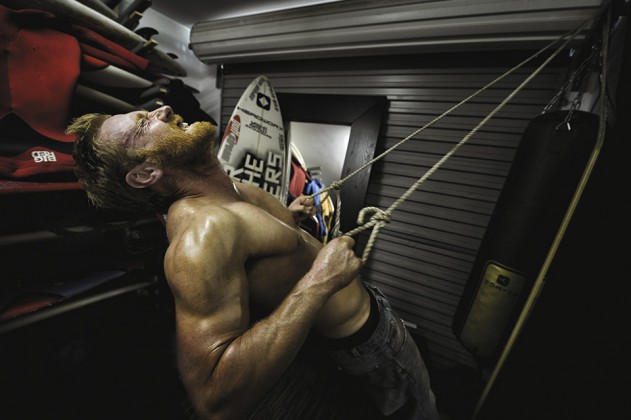To prepare for his crossing from Northern Ireland to the Isle of Jura, Scotland, Al Mennie embarked on a strict routine that kept him out of the water whenever he wasn’t training. Thinking of planning a crossing in the choppy, tidal British Isles? Al’s trainer, Richard Robinson lays down the path of pain…
Words Richard Robinson
(This feature originally appeared in the Spring 2013 issue of SUP International. Print and digital subscriptions for readers worldwide are available HERE.)
The Problem
Al Mennie wants to paddle from Ireland to Scotland –the most awkward route- in winter – in eight weeks time!
The Plan
I had been working with Alastair Mennie to maximise his training for big wave, particularly tow-in, surfing. I had tailored exercise and nutrition plans to his specific goals, and periodised his training to ensure he peaked at critical times of the year. If Al hadn’t had such a high level of physical fitness through this training, this challenge would have been impossible. Even with that, the next eight weeks were going to be critical. The three main components considered: Training, Nutrition, Recovery.
Training
Training is perhaps the simplest, as this is what most people concentrate on. For this challenge, I had to force Al’s body to adapt to the demands that would be put on it – extreme localised muscle endurance (the ability of the muscle(s) involved shoulders, back, etc, to continuously repeat a movement) and cardio vascular fitness (ability to take in and use oxygen). A training schedule was devised that included LSD (long slow distance) paddles that varied in distance from 5-23 miles, to target muscular endurance and base level CV. These paddles were done on the expedition board, to mimic challenge conditions as closely as possible. The LSD paddles were also interspersed with 20-35 minute sprint paddle sessions, conducted on a 9-foot board. These forced the muscles to deal with lactic acid build up (the heavy muscle feeling) and compelled the CV system to adapt to oxygen debt scenarios. These two training schemes, combined strategically, put the maximum adaptable stress on the body, therefore coercing it to change as quickly as possible.
During this, Al’s body was walking a cliff edge: any additional stress could have pushed it off the edge and into injury. To ensure anatomical changes – not injury and illness – I had to enforce two protocols. Firstly, no other activities or sports (no surfing or leisure paddles) – not well received; secondly, protein intake was upped to provide a positive anabolic environment for the body (more food) – well received!
Nutrition
I had already advised Al on his dietary requirements for his big wave training, so we just had to tweak his normal diet during the eight weeks to compensate for the extra training. It was the nutrition for the actual day that I knew would make or break the challenge. I investigated feeding protocols for ultra-distance paddlers, runners and swimmers and formulated a research-backed feeding schedule. A sugar-based solution, with the water and sugar content worked out for both Al’s weight and the estimated activity time, was formulated. A mix of sugars has been proven to work more effectively, with up to 75% increase in muscle carbohydrate oxidation (the ability of the muscle to take in and burn carbohydrates as a fuel source). The mix of carbohydrate sources was experimented on during the long practice paddles. It was done at this stage, as the downside to the sugar combinations can be gastrointestinal distress – not something you want to find out on race day! The dose protocol devised was a maximum stop of 15 seconds, every 15 mins. This may appear harsh, but the simple truth was that a five-minute rest every hour (perceived as very little) would have added over 45 minutes’ extra time in the water over the course of the challenge.
Recovery
Finally, recovery was taken into consideration. As stated, no other activities were allowed during training in order to accommodate recovery. The body doesn’t adapt and improve during training: it is when resting and eating in the hours and days afterwards that this occurs. Secondly, an often overlooked factor is training taper. By this I mean that training time over the last two weeks is greatly reduced – almost eliminated. Training inside this two-week window will not contribute to any physical adaptation (too short a time period) but will greatly increase the risk and likelihood of injury. The taper means that come race day, the body is primed for activity following rest and – mentally – the paddler hasn’t been in the water so is really champing at the bit.
The third part of recovery is post-race recovery. Research on Hawaiian Ironman competitors shows that the immune system function is reduced by 50% for up to 30 days post race. This illustrates the immense stress the body is under during feats of ultra endurance. No structured physical exercise should be done for two weeks post activity, and then only added in slowly over the following two weeks. Unfortunately for Al, he went a bit off track on this advice and went surfing 10 days after his 9½-hour mammoth mission. He lasted 20 minutes! He had to exit the water due to extreme exhaustion and took an extra two weeks to get back into training. Got to love his spirit, though! SUP
Richard Robinson is a Sports Scientist and qualified lecturer. He has over 15 years experience of teaching trainers and running his own strength and conditioning business, working with a varied level of clients and helping them achieve their goals. He is a drug free bodybuilder and former Mr Athletic UK. He can be contacted through www.Bespoke-pt.co.uk
“ Al’s body was walking a cliff edge: any additional stress could have pushed it off the edge and into injury. To ensure anatomical changes – not injury and illness – I had to
ban him from surfing and leisure paddles ”

